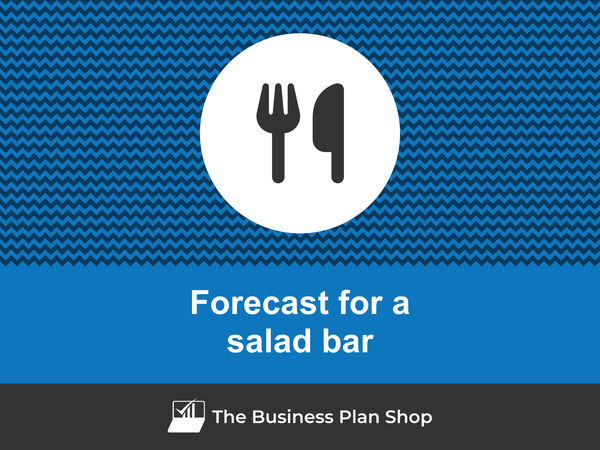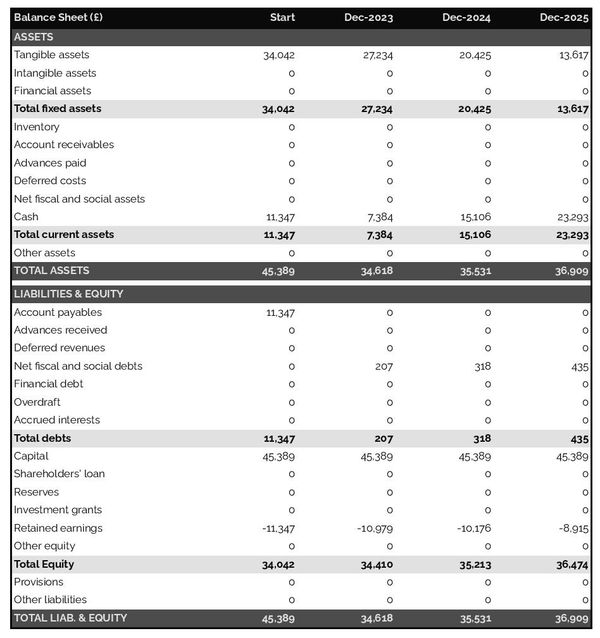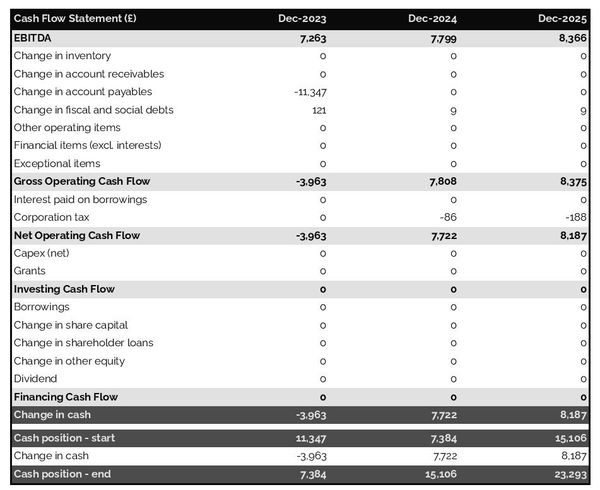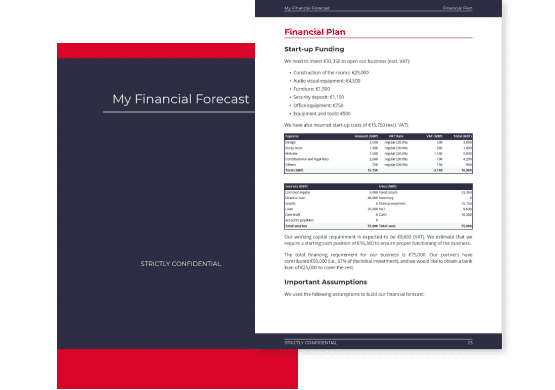How to create a financial forecast for a salad bar?

Developing and maintaining an up-to-date financial forecast for your salad bar is key in order to maintain visibility on your business’s future cash flows.
If you feel overwhelmed at the thought of putting together a salad bar financial forecast then don’t worry as this guide is here to help you.
We'll cover everything from: the main objectives of a financial forecast, the data you need to gather before starting, to the tables that compose it, and the tools that will help you create and maintain your forecast efficiently.
Let's get started!
Why create and maintain a financial forecast for a salad bar?
The financial projections for your salad bar act as a financial blueprint to guide its growth with confidence and ensure its long-term financial viability.
To create them, you will need to look at your business in detail - from sales to operating costs and investments - to assess how much profit it can generate in the years to come and what will be the associated cash flows.
During challenging market conditions, maintaining an up-to-date financial forecast enables early detection of potential financial shortfalls, allowing for timely adjustments or securing financing before facing a cash crisis.
Your salad bar's financial forecast will also prove invaluable when seeking financing. Banks and investors will undoubtedly request a thorough examination of your financial figures, making precision and presentation essential.
Need a solid financial forecast?
The Business Plan Shop does the maths for you. Simply enter your revenues, costs and investments. Click save and our online tool builds a three-way forecast for you instantly.

What information is used as input to build a salad bar financial forecast?
A salad bar's financial forecast is only as good as the inputs used to build it.
If you are creating (or updating) the forecast of an existing salad bar, then you mostly need your accounting information, key historical operating non-financial data, and your team’s input on what to expect for the coming years.
If you are building financial projections for a salad bar startup, you will need to have done your research and have a clear picture of your competitive environment and go-to-market strategy so that you can forecast sales accurately.
For a new venture, you will also need a precise list of the resources needed to keep the salad bar running on a day-to-day basis and a list of the equipment and expenditures required to start the business (more on that later).
Let's now take a closer look at the elements that make up your salad bar's financial forecast.
The sales forecast for a salad bar
The sales forecast, also called topline projection, is normally where you will start when building your salad bar financial forecast.
Creating a coherent sales projection boils down to estimating two key drivers:
- The average price
- The number of monthly transactions
To do this, you will need to rely on historical data (for an existing business), market research data (for both new and existing salad bars), and consider the elements below:
- The availability and cost of fresh produce can greatly impact the average price of your salads. For example, a decrease in supply due to weather conditions can result in higher prices for certain ingredients, causing your overall prices to increase.
- The popularity of healthy eating trends and dietary restrictions can also affect the number of monthly transactions at your salad bar. If there is a rise in demand for plant-based or gluten-free options, you may see an increase in customers and sales.
- The location of your salad bar can play a significant role in the number of monthly transactions. If your business is located in a busy office district, you may experience higher sales during lunch hours compared to a location in a residential area.
- Seasonal changes can also impact the average price and number of transactions at a salad bar. For example, during the summer months, customers may be more inclined to purchase refreshing and lighter salads, while in the winter, heartier and warmer options may be preferred.
- The variety and quality of toppings and dressings offered at your salad bar can also influence your sales. An extensive selection of toppings and homemade dressings can attract more customers and potentially justify higher prices for your salads.
After the sales forecast comes the operating expenses budget, which we will now look into in more detail.
Need inspiration for your business plan?
The Business Plan Shop has dozens of business plan templates that you can use to get a clear idea of what a complete business plan looks like.

The operating expenses for a salad bar
The next step is to estimate the costs you’ll have to incur to operate your salad bar.
These will vary based on where your business is located, and its overall size (level of sales, personnel, etc.).
But your salad bar's operating expenses should normally include the following items:
- Staff Costs: This includes salaries, wages, and benefits for employees working at the salad bar such as chefs, servers, and cashiers.
- Food and Beverage Costs: This covers the cost of ingredients and supplies needed to create salads and other menu items.
- Rent: This is the cost of leasing the space where the salad bar is located.
- Utilities: This includes electricity, water, gas, and other necessary utilities for running the salad bar.
- Marketing and Advertising: This covers the cost of promoting the salad bar through various channels such as social media, flyers, and local advertisements.
- Insurance: This includes general liability insurance, property insurance, and worker's compensation insurance to protect the business and employees.
- Accountancy Fees: This covers the cost of hiring an accountant or bookkeeper to manage the financial records and taxes for the salad bar.
- Software Licenses: This includes any software or programs needed to run the salad bar such as point-of-sale systems or inventory management software.
- Banking Fees: This covers the cost of maintaining a business bank account and any fees associated with transactions and services.
- Cleaning and Maintenance: This includes the cost of cleaning supplies and any repairs or maintenance needed for the salad bar equipment and facilities.
- Uniforms: This covers the cost of purchasing and maintaining uniforms for employees to wear while working at the salad bar.
- Training and Development: This includes the cost of training new employees and providing ongoing development opportunities for current staff members.
- Packaging and Takeout Supplies: This covers the cost of to-go containers, napkins, and other supplies needed for customers who order food to-go.
- Waste Management: This includes the cost of garbage and recycling services for the salad bar.
- Office Supplies: This covers the cost of purchasing office supplies such as printer paper, ink, and pens for administrative tasks.
This list is not exhaustive by any means, and will need to be tailored to your salad bar's specific circumstances.
What investments are needed to start or grow a salad bar?
Creating and expanding a salad bar also requires investments which you need to factor into your financial forecast.
Capital expenditures and initial working capital items for a salad bar could include elements such as:
- Salad bar equipment: This includes items such as refrigerators, freezers, salad bar display cases, and food prep stations. These are essential for storing and presenting the salad bar items in a safe and visually appealing manner.
- Point-of-sale system: A reliable and efficient POS system is necessary for accurately tracking sales, managing inventory, and processing payments. This is especially important for a salad bar as it allows for easy customization and tracking of items.
- Furniture and fixtures: This includes tables, chairs, and other seating options for customers to enjoy their salads. Additionally, you may also need to invest in display racks, utensils, and other smaller items to enhance the overall dining experience.
- Kitchen equipment: While this may not be directly related to the salad bar, it is important to invest in quality kitchen equipment such as ovens, stoves, and cooking utensils. This will ensure efficient food preparation and help maintain the freshness and quality of the salad bar items.
- Renovations or remodeling: Depending on the location and condition of your space, you may need to invest in renovations or remodeling to create a suitable and attractive environment for your salad bar. This could include things like flooring, lighting, and decor.
Again, this list is not exhaustive and will need to be adjusted according to the circumstances of your salad bar.
Need a convincing business plan?
The Business Plan Shop makes it easy to create a financial forecast to assess the potential profitability of your projects, and write a business plan that’ll wow investors.

The financing plan of your salad bar
The next step in the creation of your financial forecast for your salad bar is to think about how you might finance your business.
You will have to assess how much capital will come from shareholders (equity) and how much can be secured through banks.
Bank loans will have to be modelled so that you can separate the interest expenses from the repayments of principal, and include all this data in your forecast.
Issuing share capital and obtaining a bank loan are two of the most common ways that entrepreneurs finance their businesses.
What tables compose the financial plan for a salad bar?
Now let's have a look at the main output tables of your salad bar's financial forecast.
The profit & loss forecast
The forecasted profit & loss statement will enable you to visualise your salad bar's expected growth and profitability over the next three to five years.

A financially viable P&L statement for a salad bar should normally show:
- Sales growing above inflation
- Stable or expanding (ideally) profit margins
- A net profit
This will of course depend on the stage of your business: a new venture might be loss-making until it reaches its breakeven point in year 2 or 3, for example.
The projected balance sheet
The projected balance sheet gives an overview of your salad bar's financial structure at the end of the financial year.
It is composed of three categories of items: assets, liabilities and equity:
- Assets: are what the business possesses and uses to produce cash flows. It includes resources such as cash, buildings, equipment, and accounts receivable (money owed by clients).
- Liabilities: are the debts of your salad bar. They include accounts payable (money owed to suppliers), taxes due and bank loans.
- Equity: is the combination of what has been invested by the business owners and the cumulative profits to date (which are called retained earnings). Equity is a proxy for the value of the owner's stake in the business.

The cash flow projection
The cash flow forecast of your salad bar will show how much cash the business is expected to generate or consume over the next three to five years.

There are multiple ways of presenting a cash flow forecast but from experience, it is better to organise it by nature in order to clearly show these elements:
- Operating cash flow: how much cash is generated by the salad bar's operations
- Investing cash flow: what is the business investing to expand or maintain its equipment
- Financing cash flow: is the business raising additional funds or repaying financiers (debt repayment, dividends)
Your cash flow forecast is the most important element of your overall financial projection and that’s where you should focus your attention to ensure that your salad bar is adequately funded.
Note: if you are preparing a financial forecast in order to try to secure funding, you will need to include both a yearly and monthly cash flow forecast in your salad bar's financial plan.
Need a solid financial forecast?
The Business Plan Shop does the maths for you. Simply enter your revenues, costs and investments. Click save and our online tool builds a three-way forecast for you instantly.

Which tool should you use to create your salad bar's financial forecast?
Using the right tool or solution will make the creation of your salad bar's financial forecast much easier than it sounds. Let’s explore the main options.
Using online financial forecasting software to build your salad bar's projections
The modern and easiest way is to use an online financial forecasting tool such as the one we offer at The Business Plan Shop.
There are several advantages to using specialised software:
- You can easily create your financial forecast by letting the software take care of the financial calculations for you without errors
- You have access to complete financial forecast templates
- You get a complete financial forecast ready to be sent to your bank or investors
- You can easily track your actual financial performance against your financial forecast, and recalibrate your forecast as the year goes by
- You can create scenarios to stress test your forecast's main assumptions
- You can easily update your forecast as time goes by to maintain visibility on future cash flows
- You have a friendly support team on standby to assist you when you are stuck
- It’s cost-efficient and much cheaper than using an accountant or consultant (see below)
If you are interested in this type of solution, you can try our projection software for free by signing up here.
Calling in a financial consultant or chartered accountant
Outsourcing the creation of your salad bar financial forecast is another possible solution.
This will cost more than using software as you can expect as your price will have to cover the accountant’s time, software cost, and profit margin.
Price can vary greatly based on the complexity of your business. For a small business, from experience, a simple three-year financial forecast (including a balance sheet, income statement, and cash flow statement) will start at around £700 or $1,000.
Bear in mind that this is for forecasts produced at a single point in time, updating or tracking your forecast against actuals will cost extra.
If you decide to outsource your forecasting:
- Make sure the professional has direct experience in your industry and is able to challenge your assumptions constructively.
- Steer away from consultants using sectorial ratios to build their client’s financial forecasts (these projections are worthless for a small business).
Why not use a spreadsheet such as Excel or Google Sheets to build your salad bar's financial forecast?
You and your financial partners need numbers you can trust. Unless you have studied finance or accounting, creating a trustworthy and error-free salad bar financial forecast on a spreadsheet is likely to prove challenging.
Financial modelling is very technical by nature and requires a solid grasp of accounting principles to be done without errors. This means that using spreadsheet software like Excel or Google Sheets to create accurate financial forecasts is out of reach for most business owners.
Creating forecasts in Excel is also inefficient nowadays:
- Software has advanced to the point where forecasting can be done much faster and more accurately than manually on a spreadsheet.
- With artificial intelligence, the software is capable of detecting mistakes and helping decision-making.
Spreadsheets are versatile tools but they are not tailor-made for reporting. Importing your salad bar's accounting data in Excel to track actual vs. forecast is incredibly manual and tedious (and so is keeping forecasts up to date). It is much faster to use dedicated financial planning tools like The Business Plan Shop which are built specially for this.
Need a convincing business plan?
The Business Plan Shop makes it easy to create a financial forecast to assess the potential profitability of your projects, and write a business plan that’ll wow investors.

Use our financial forecast templates for inspiration
The Business Plan Shop has dozens of financial forecast examples available.
Our templates contain both a financial forecast and a written business plan which presents, in detail, the company, the team, the strategy, and the medium-term objectives.
Our templates are a great source of inspiration, whether you just want to see what a complete business plan looks like, or are looking for concrete examples of how you should model financial elements in your own forecast.

Takeaways
- A financial projection shows expected growth, profitability, and cash generation for your business over the next three to five years.
- Tracking actuals vs. forecast and keeping your financial forecast up-to-date is the only way to maintain visibility on future cash flows.
- Using financial forecasting software makes it easy to create and maintain up-to-date projections for your salad bar.
You have reached the end of our guide. We hope you now have a better understanding of how to create a financial forecast for a salad bar. Don't hesitate to contact our team if you have any questions or want to share your experience building forecasts!
Need inspiration for your business plan?
The Business Plan Shop has dozens of business plan templates that you can use to get a clear idea of what a complete business plan looks like.

Also on The Business Plan Shop
Know someone who runs or wants to start a salad bar? Share our financial projection guide with them!




